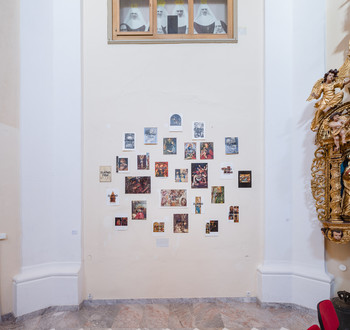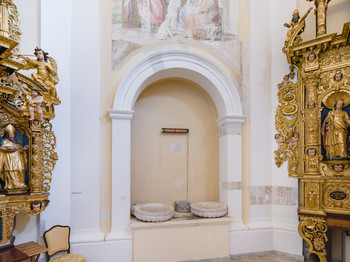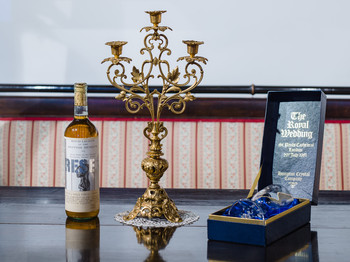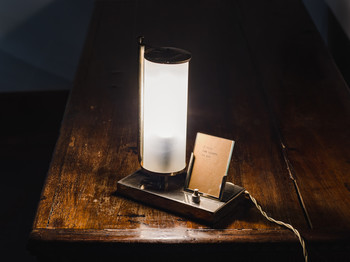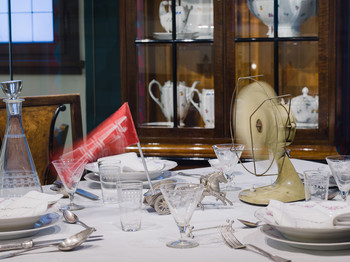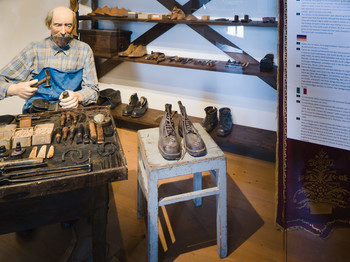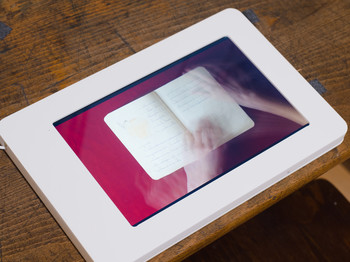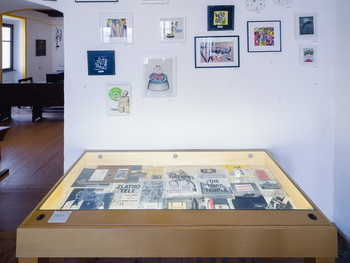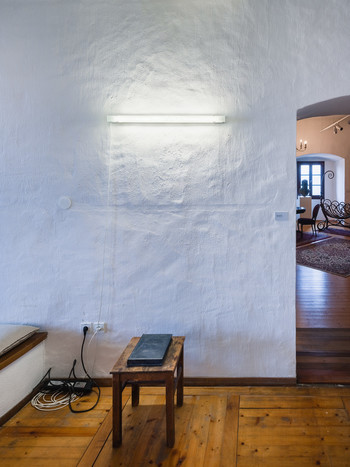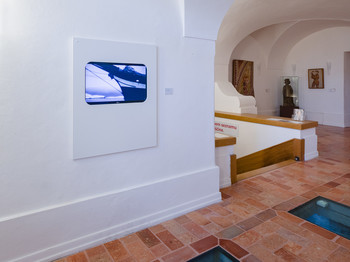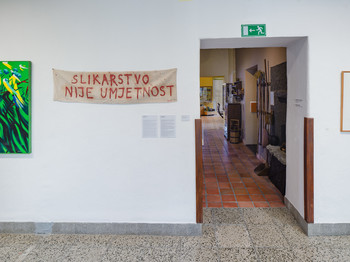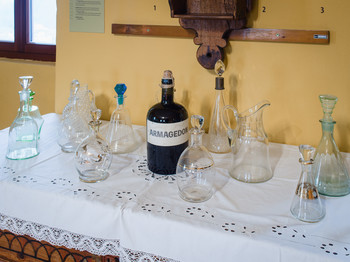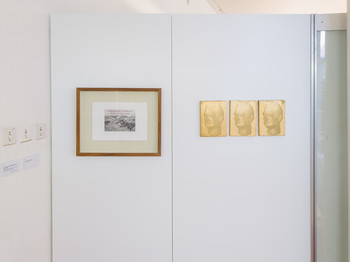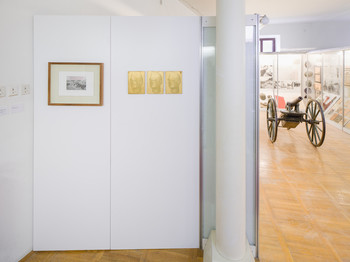Golden Calf, 2016
After Moses returned from Mount Sinai with the Ten Commandments engraved on stone tablets, he found Israelites idolizing a golden calf, which he then proceeded to smash in anger. The second commandment clearly says: “Thou shalt not make unto thee any graven images.”
Brajnović uses this Old Testament story to confirm his thesis that Christianity is essentially an idea, so all illustrations of spiritual space are superfluous and even contrary to the word of God.
The installation consists of 27 original reproductions of works of art, statues of saints, paintings of biblical stories from old art books. On these images, the pinnacles of European art, he screen-printed the inscription golden calf.
In Gold We Trust, 2004
This work was created during Brajnović’s studies in England, where he gathered a large number of sayings containing the word GOD, most often in connection with the king, queen, nation. He changed the meaning of the word by adding the letter L, changing the concept of God to gold and with it also the meaning of famous Anglo-Saxon sayings. For it was gold, not God, that was the real principle underlying the conquests by the British Empire.
Royal Wedding, 2022
A bottle of the Reset wine, fitted with a label featuring an African sculpture from the British Museum, sits next to an anniversary cup from Charles and Lady Diana's royal wedding.
Reset is a natural wine that Brajnović has been producing in boutique quantities at Golo Brdo for the last few years. He designed different themed labels for the series.
The piece is a reference to colonialism, which was most magisterially carried out and symbolised by the royal family. In recent years, the British Museum has come under strong pressure from various countries demanding the return of valuable cultural heritage that was taken by colonialists, soldiers and other adventurers. The same is true for other established museums where the bulk of their collections originated as loot from colonial times.
In Paradise There Is Space For Everybody, 2007
A typed text placed in a vintage frame lit by an old cylindrical (bedside) lamp.
The piece originates from the artist's belief that quarrels and wars over the question of which religion is correct are superfluous, because there is certainly enough room for everyone in paradise.
Flag, 2016
Brajnović here refers to Slovenian philosopher Slavoj Žižek who in one of his interviews talked about a Direct Link, the idea describing a joining of brain and machine, i.e. a digital cloud. Brajnović came to the conclusion that this is one of the signs that technology has bested man, that Žižek’s predicted cyborgs will abolish subjectivity, humanity (as labelled by Žižek) and with them humankind. Moreover, Armageddon, the final battle between good and evil prior to the final judgment, is unavoidable.
Brajnović has researched, predicted and visualized Armageddon in several of his works during the last five years. The fan blows air onto the flag at short intervals. The flag is his father's: Brajnović print-screened God’s original name onto red cloth.
With this installation, the artist is staging the beginning of Armageddon.
The Left and the Right, 2019
As Brajnović bought a pair of old leather shoes at a flea market, he got an association between them and the political left and right, with two shoes worn on the two feet of the same ruler. The artist sees the two as parts of a larger whole, so sharp divisions into (political) left and right are unnecessary. For humanity to move towards a better society, both need to cooperate.
Mozart, 2016
Video, original notebook in a golden fame, 23:57
Video: Igor Paulić
The video was created as a reaction to a notebook that the artist bought at a small antiques fair in Trieste. Made by a primary school student in Italy just before WWII, the notebook contains lessons taught at the time in a child’s writing, with vibrant colours and drawings: the glorification of the king, of the Duce, fascist movement leader Benito Mussolini, the church, the conquest of Abyssinia, Ethiopia, fascist culture.
The video was created in collaboration with actress Sara Alzetta, who read through the pages in one go in a neutral voice. Spectators are thus given an insight and pushed into an uneasy awareness of the dichotomy between theory and practice. The education system is supposed to be ideologically neutral in principle, but it is often a vivid illustration of extreme ideologies.
All the Tables are Full..., 2018
Brajnović, a long-time visitor to antiques fairs, antique shops and flea markets, is a collector of glassware, ceramics, postcards, textiles, books, photographs, as well as other small items of cultural heritage. His collection serves as an inspiration, a source of ideas, a creative archive, and he often uses these objects as elements in his works of art.
As part of the series All the Tables are Full, we see the artist presented through materials used for his current projects, the ideas for a future piece of art. An exhibition within an exhibition and an artist's biography all in one.
Art History / Book of Life, 2015
The work consists of a leaden cast of the book Art History, which Brajnović bought in an antique shop in Belgrade, and a screen-printed text (with transparent varnish) on sandblasted glass called The Book of Life. Both elements form a whole and illustrate the relationship between two human aspirations; the ambition that one’s name be recorded in a book of human history or a book of spiritual history, i.e. God’s book of life.
Supper with the Artist
A series of closed events starting in 2010, Golo Brdo and various other locations
Homestead par Strojari, Poljane nad Škofjo Loko, 24 September 2022
Photo: Janez Pelko
Since 2010, Brajnović has been hosting a series of events entitled Supper with the Artist. Originally (and most often) held at his studio on Golo Brdo near Rovinjsko Selo village in Istria, Croatia, as part of work-related or friendly visits by curators, artists, and a changing set of cultural workers, these suppers also include winemakers and other people of interest to Brajnović. Since September 2010, as part of his exhibitions abroad, he occasionally organizes a mobile version accompanying his exhibition as a closed event at an apartment or gallery. This time it was organised in collaboration with cultural heritage lover and collector Janez Kloboves at his homestead in Poljane nad Škofjo Loko. Kloboves has been collecting and exhibiting many exceptional objects from the recent past in the venerable building – once his grandfather's tannery – where he resides, transforming it into a spatial installation containing a series of small exhibitions/installations of antiques, works of art, and everyday objects.
This, at first glance, an ordinary culinary and social event is actually a happening at a spatial installation where everything matters, from guests, objects to food and drink.
The basic scenography of the room where the supper takes place is a simple but well-thought through installation of objects of contemporary art and living heritage. In the supper’s main venue, an artist studio that Brajnović built himself, he displays an ever-changing retrospective of his work alongside numerous items from his extensive and continuously growing ethnological/cultural history collection. The scenography of these mobile suppers consists of a set of old dishes, fabrics and lights belonging to Brajnović, which he combines with selected other items at the hosting venue into a spatial installation, including a long central table with the necessary crockery, tablecloths and utensils.
Brajnović always cooks by himself, occasionally with the help of his wife, local colleagues and guests. The food is carefully selected, local, seasonal, simple, naturally produced: cheese, wine, olives, tomatoes. When visiting, he incorporates the essential ingredients from his own environment and incorporates them into the menu, otherwise created together with the locals.
His DIY process, extensively used in his arts production, has been taken the furthest with wine. For years, he has been friends and worked with a local winemaker Marinko Pavlovič - Maka, who planted a new organic vineyard several years ago and started micro-producing organic wine. Brajnović has also taken up the practice in recent years and now produces his own wine in a boutique quantity. He works three long-abandoned vineyards, which the owners let him cultivate in exchange for taking care of them and he planted some grapevine himself on Golo Brdo. The miniscule amount of wine he produces is consumed at suppers or used for his other projects. Brajnović started one of them, the Armageddon series of wine, in 2019, when he produced the first few litres on Golo Brdo. He will finish the series with the seventh edition; at this supper, the centrepiece was Armageddon 3.0.
For some suppers he also prepares special bottles with labels that are part of his Friends project, a tribute to giants of Croatian conceptual art.
Supper with the Artist is a living demonstration of the idea that cultures always interact with and build upon each other. Here the word cultures is used in many senses: visual, gastronomic, ethnological, living...
Supper with the Artist is also unique because it is Brajnović’s longest ongoing project, and it seems that over the years he has turned it into a concrete, complex manifestation of all levels of his artistic practice.
Every supper also leaves behind a few photographs. Sometimes a photo is included in the exhibition.
Ego Trip Noorderlicht, 2009
Video: Janet Biggs, 5:21
The Arctic Circle project/expedition was organized in October 2009 by New York’s The Farm Foundation. Fifteen artists, three scientists and a team (the foundation director, a journalist and five crew members) sailed for fifteen days around the fjords of Svalbard, approximately 1,000 km from the North Pole. Their hundred-year-old wooden sailboat became a temporary incubator for thinking, investigation and cooperation by its carefully selected passengers. The harsh conditions in the fjords, the usual starting point of expeditions to conquer the far north, dictated how artistic projects and scientific research were carried out. Outside the ship, the cold, dangerous ice and wild animals meant they could only move about in a group. Even living on the old wooden sailing ship, a piece of cultural heritage itself, required a lot of adaptation and cooperation. Especially those artists, who embarked with already devised concepts of works of art they wanted to create during this extraordinary opportunity in an extraordinary environment, were forced to cooperate and work together in developing and executing their projects during the expedition.
The Ego Trip Noorderlicht video, recorded on the ship, is part of his multi-year Ego Trip series, where Brajnović examines the human ego. The series consists of photographs (and the mentioned video) of the artist always in the same outfit with a “mysteriously” illuminated face in different parts of the art world (from New York to Venice), taken in a specific light as the day turns to evening. Brajnović made the suit and its independent lighting himself.
The series uses staged lit photos to symbolically visualize the ego, otherwise invisible to the eye, which, according to Brajnović, often misdirects a person's activities selfishly towards oneself, rather than towards the society to which one belongs. This series sheds the light on what some members of the Arctic expedition also invisibly put aside when they were forced to exchange preconceived ambitious individual art pieces for the collective creation of common projects.
Greed, Speed, Fire, History, 2009
At one of the outings during the Arctic Circle expedition, when the group could only leave the ship with an armed escort, Brajnović made and photographed a series of interventions, inscriptions in the snow, in front an abandoned quarry, a former site of human settlers (mostly gold diggers), which, beautifully preserved by the cold, symbolize the greed of our civilization.
Painting is not Art, 2011
Finger writing in red paint on raw linen cloth, artist’s text
The work is a reaction to the inaugural Biennale of Painting in Zagreb, organised in 2011. Brajnović sent the canvas and the text to the competition, arguing that the concept of the biennale, which divides media into contemporary and dead/non-contemporary ones, is fundamentally wrong. For Brajnović, there is no obsolete medium, only artists. A contemporary artist is not considered contemporary because of the medium they use; a painting can be contemporary and a video installation obsolete. Contemporaneity is defined by the artist's idea presented in the medium that is most suitable for it, be it a painting, video or spatial installation.
He was not selected.
Armageddon, 2019
Brajnović produced the first bottle of the Armageddon wine series in 2019, using grapes from Golo Brdo. The current bottle is iteration 3.0 and the artist announced he will make a series of seven. He exhibited the first bottles at an exhibition in Slavonski Brod, they were part of a performance in Graz, one was used as part of the Supper with the Artist, an event that is also accompanying this exhibition, for which it was documented and included as a photograph (see no. 10).
A prototype used for the Armageddon wine bottles 1.0 and 2.0 stands among a selection of empty old bottles from Brajnović's collection. The artist illustrates his thesis that the postmodern position which states that there is not one single truth, but rather a collection of different narratives, theories, stories and views, is wrong. He is convinced that Truth exists, regardless of whether we recognize it or not. All the bottles except Armageddon are empty.
This bottle of red wine is a direct association to rage, blood and is also an extremely important symbol of Christ's sacrifice.
Kožarevo zlato*, 1998
In 1998, Ivan Kožarić, one of the most important contemporary Croatian sculptors, made a bust of Franjo Tuđman, Croatian general and historian who served as the first president of the Republic of Croatia after the breakup of Yugoslavia between 1990 and his death in 1999.
Brajnović sought the subversiveness, characteristic of Kožarić's work, in the president’s bust, but failed to find it. The contrast between Kožarić's decades-long artistic practice where he often critically portrayed/reflected on power structures and the celebratory bust of the autocratic Croatian president confused him.
Brajnović reacted by screen-printing a reproduction of the bust, published in a newspaper, with gold paint on a golden background. The work is a reference to Kožarić's famous series of gold works from 1971, when he painted all objects, both artistic and non-artistic, in gold in his studio at Medulićeva Street 12 in Zagreb.
Brajnović used a newspaper photo with a visible raster in a lower resolution and made three identical copies, exhibiting them as a triptych. His aim was to draw attention from the form/image (the original bust) to its content. Gold has a dark shine in Brajnović's work, because according to him, it signifies the reputation that a renowned artist bestowed onto his problematic motif, an authoritarian populist politician. Value, even artistic value, is not absolute, worthless can become art and art can become worthless.
*The title Kožarevo zlato (Kožar’s Gold) is an untranslatable word play and was therefore left in the original. It is a small parody aimed at Kožarević by altering his surname and alludes to the famous book by August Šenoa Zlatarovo zlato (The Goldsmith’s Treasure).
L'artiste est un soldat dans les blés mûrs, 2015
Artist is a Soldier in Ripe Wheat, 22:26
The piece Artist is a Soldier in Ripe Wheat consists of an audio recording and an original graphic with a screen-printed text.
Its title originates from a provocative question about the difference between artists and tourists, asked by journalist Matt Holzman to the artists taking part in the 2009 Arctic expedition. The question triggered Brajnović to think about the role and obligations of an artist, and a few years later, while browsing an antique shop in Belgium, the answer suddenly appeared. It was in the shape of an original gravure graphic from 1888, which shows soldiers battling in ripe grain. The piece is entitled “Les blés sont mûrs”, the grain is ripe. He screen-printed the text “L'artiste est un soldat dans les blés mûrs” (Artist is a Soldier in Ripe Wheat) in French on the graphic, framed it and combined it with the audio piece into a new work with the same title.
Brajnović and other participants of the Arctic expedition felt almost obliged to create a good work of art in order to justify their participation in the unique and logistically demanding trip, organised just for a select few. This in itself contradicts the essence of art. Brajnović did not feel like a tourist or an artist on the expedition, but rather like a soldier on a mission in beautiful nature that he does not even perceive.
He added an audio recording entitled Soldier in Ripe Wheat, which was made as an independent work in 2015 for the audio “Slika od zvuka” (Images from Sound) show, broadcast by channel three of the Croatian National Radio on June 13, 2015. It consists of audio recordings from the artist's personal archive as well as his texts and short posts on Facebook over a long period of time, which are read by two professional announcers. The female announcer reads the more poetic ones, the male announcer more philosophical. Their superb diction and “radio” voice give the work additional gravitas and persuasiveness. Various sound recordings, melodies from digitized records, historical political speeches and music from the times and memories of the artist's childhood are interspersed among the read texts.
The work addresses the responsibilities and tasks of today’s artists, about the importance of art in a wider social context, about art as a way of thinking. Apart from that it also touches on the mental position of a soldier - an artist who is on an important mission amidst beautiful nature, ripe wheat that no one will harvest. The project reads as despair and sadness over historical helplessness and failure of man.

